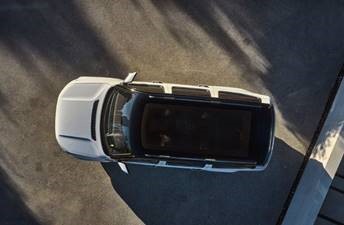The All New Jeep Wagoneer: Coming 2021
- Casey
- Sep 4, 2020
- 4 min read

In 1963, the Wagoneer completely changed the SUV market with an unprecedented combination of off- road capability and passenger comfort leaving a legacy unlike any other SUV.
1960’s
While luxury SUVs may seem ubiquitous on today's roads, back in the 1960s, Jeep took a risk when it introduced the Wagoneer. The company already had the rough-and-tumble CJ-5 and CJ-6 civilian Jeeps and it was looking for a leg up on the larger full-size offerings from Chevrolet and Dodge.
Built in 1962 as a 1963 model, the Wagoneer was meant to be a fancy-pants hauler that featured passenger car comfort and styling with the added benefit of four-wheel drive, although rear-wheel drive was available for the first few years. Regardless, the Wagoneer marked the first time a four-wheel-drive vehicle was outfitted with independent front suspension and an automatic transmission. However, solid axles and a manual transmission were on the menu.
This first Wagoneer was available in two- or four-door models, powered by a 3.8-liter Tornado inline-six engine pushing out 140 horsepower and 210 pound-feet of torque. Power went to the pavement through a three-speed automatic or manual transmission. A 5.4-liter Vigilante V8 came online in 1965 with 250 hp and 340 lb-ft.

Two years after the Wagoneer's debut, Jeep went a step further introducing the Super Wagoneer, or Super Custom as it was sometimes called. Produced for the 1966 model year, It included air conditioning, power brakes and steering, an adjustable steering wheel, power tailgate, tinted windows, pushbutton radio and other niceties. Under the hood was that same Vigilante V8, now with 270 hp and 340 lb-ft.
Customers paid a pretty penny for the Super Wagoneer. It cost $5,943, or almost double the price of the standard Wagoneer. Considering the median income in 1965 was $6,900, the Super Wagoneer was super expensive. It was put to bed in 1969.
1970’s
American Motors Corporation took over Jeep in 1970 and kept the Wagoneer progressing through the decade. By 1972 it had introduced a 4.2-liter straight-six engine as well as 360-cubic-inch and 401-cubic-inch V8s mated to a three- or four-speed manual

or a three-speed automatic transmission. However, the company more importantly pioneered the Quadra-Trac four-wheel-drive system in 1973. This full-time four-wheel-drive system meant drivers no longer had to get out and lock the hubs in order to power the front wheels. The Wagoneer did it all on its own.
1975 marked the first time we see the wood grain exterior applique that eventually became synonymous with the model, and it continued on to the Wagoneer Limited, introduced in 1978. Meant to be a successor to the Super Wagoneer, the Limited was
uber-fancy with leather upholstery, cruise control, disc brakes, as well as power seats, steering and windows. Heck, it even had a standard AM/FM/CB radio. Drivers could get a 5.9-liter V8 or go big with a 6.6-liter V8.
1980’s
A styling change went into effect in 1979 with the Wagoneer losing its round headlights in favor of square lamps. The grill protruded out a bit from the center, giving the Wagoneer a porcine look and was referred to as the "pig nose grille" until its demise in 1985.
The Wagoneer remained fairly unchanged until 1984, when things got a little weird. That's when the small, unibody XJ Cherokee was introduced. Jeep moved the Wagoneer name to the smaller XJ platform, where it became more of a trim line than a separate model. The Wagoneer followed the whims of the Cherokee until it was discontinued in 1991.
This left room for a new, larger Grand Wagoneer in 1984, with such standard niceties as air conditioning, a leather-wrapped tilt steering wheel, power windows and door locks and a power rear hatch window. The Grand Wagoneer came standard with a 4.2-liter I6 engine with 110 hp and 210 lb-ft of torque, though buyers could opt for a 5.9-liter V8 which added 30 more hp and 70 lb-ft of twist. Both engines were mated to a three-speed automatic transmission getting the power down to all four wheels. In 1987 the I6 was dropped and the V8 was the only powerplant on tap until the model was discontinued in 1991.
The Grand Wagoneer retained its styling throughout its life, though a few little changes were made throughout the years. In 1986 the SUV got a hood ornament, a refreshed grille and headlights as well as a revised dashboard and interior switchgear. There were incremental changes from 1987 to 1989, including a better stereo system, new door panels, keyless entry and an optional sunroof.
1990’s
By 1991 sales had given up the ghost and the Grand Wagoneer was nixed. In 1993 the name appeared briefly as a fully loaded version of the new Grand Cherokee, but it was gone by 1994.
Today
Now, more than two decades after the Grand Wagoneer left Jeep's lineup, the company is ready to breathe new life into this iconic name. Jeep has shown off a concept that previews the production model of the Grand Wagoneer. The concept features independent suspension all the way around, Quadra-Lift air suspension, three rows of seats and your choice of three four-wheel drive systems, all of which will make it to the production model.
With the excitement of Jeep’s new and improved model coming sometime next year, now is the time to snag a deal on Jeeps current models like the Wrangler, Cherokee, Grand Cherokee, and Renegade! Visit www.carite.com today to see what they have to offer!











Comments